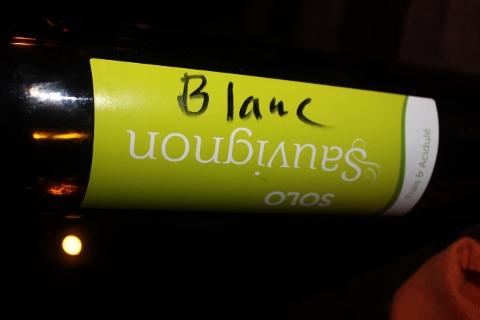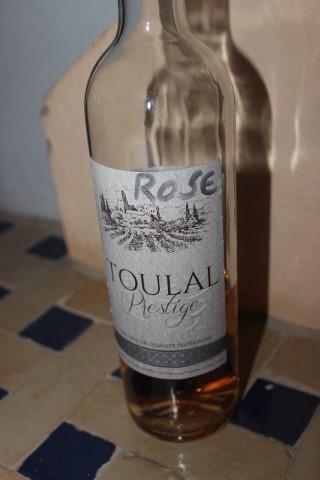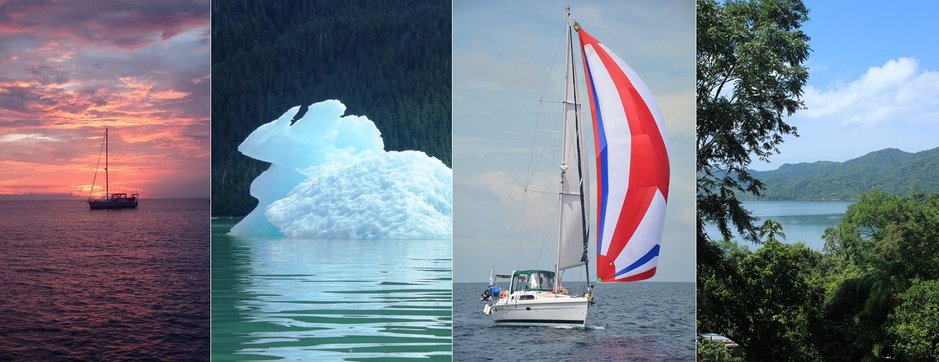We were awakened an hour before dawn at 6am by our guides – as we had planned to hike up the highest dune to watch the sunset. They had told us the night before it would take 20 to 30 minutes to hike up to amazing views. So piece-o-cake, right? We laid in bed debating how badly we wanted to see the sunset as the bed was warm and cozy. But hey, this is what we paid our money to see, yes? So we climb out of bed and get dressed and start off. Piece-of-cake my ass. Which hurts by the way. (More on that later.) Hiking in the sand is hard work. On the relatively flat parts – you can put you foot down flat and keep from breaking through the sand and its easy. But on the steep slopes up – you break through and your foot slides down the hill. So every step you make only a few inches progress up but you feel like you are trying to run up a flight of stairs. We made it about half way up before Melissa’s asthma took over (a problem particularly with all the sand in the air). None the less, the view of the sunrise over the dunes was spectacular.

We asked the guides why the camels don’t run away at night. Turns out that they hobble them by tying up their legs at the camel’s knee so that they can’t even stand up.
Ok, so here is why we are so sore… here is the way a camel saddle is constructed – out of rebar. Plenty of padding between the saddle and the camel, but only a few layers of blanket between you and the saddle. There is no way to be comfortable. Hence, we are both stiff and sore. And Melissa has a blister on one hand from hanging onto the handle.
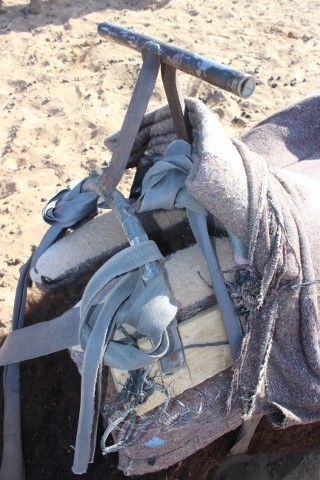
The original plan had been to trek another 3 hours today across the desert on the camel to another camp where we would spend another night, and then trek the following day another 3 hours back to the hotel. Yeah. Not. Gonna. Happen. Another 6 hours on the camels and we will be crippled. So we opt to take the 90-minute camel ride back to the hotel.
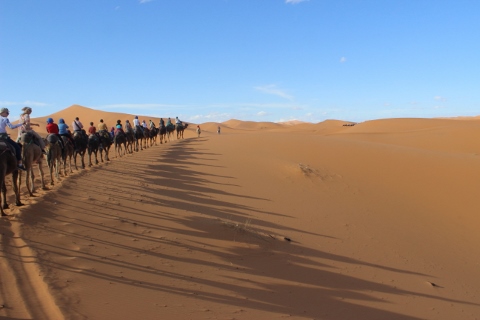
Upon arriving back at the hotel, we ask if we can pretty please stay there two nights instead of one (we were scheduled to be there tomorrow night already). Sure, no problem they say. Whew. Then they offer up that we can instead take a 4x4 into the desert and see where they dig fossils and minerals and visit a local nomad tent. Yes! That is perfect!
We then got checked in and took showers. I don’t think I’ve ever washed so much sand and dirt off. When we took off our tennis shoes we dumped piles of sand out of them. Ahhh. Then we hung out at the hotel during the heat of the day and had a bottle of nice rose wine.
As we didn’t want another Berber omelet today, we headed into a nearby town for lunch – Restaurant Nora – recommended by the hotel. Google maps found it by name – amazing us yet again how accurate they are. Only one other couple was there when we arrived. We ordered the chicken tagine and were told it would be an hour wait. While we sat there, the place sure filled up. Known for their pizza, the place was packed with tourists and tour guides.
At 5pm we piled into the 4x4 with our guide Barak. He gave us Berber names – Aziz and Fatima. He was a character.
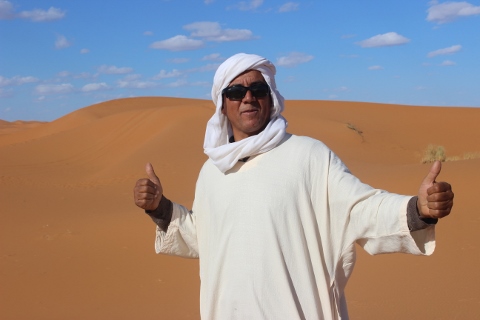
And off through the dunes we went. Though not before Barak stopped and let a bunch of air out of the tires. He lowered the PSI from about 28 to 14. This is so that the tires will be nice and fat on the sand so they don’t dig in so hard.
We then drove to a location where we could look for fossils. Barak poured water on rocks just lying on the ground and found these:
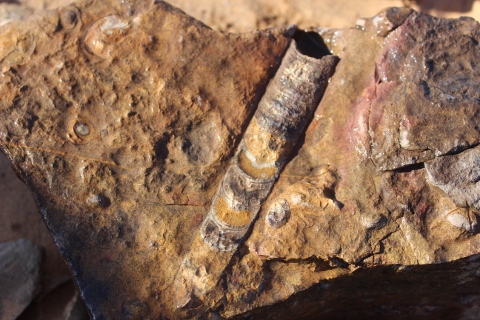
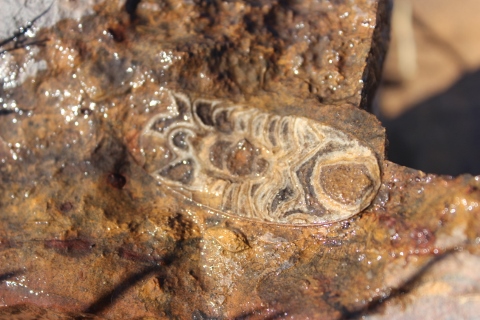
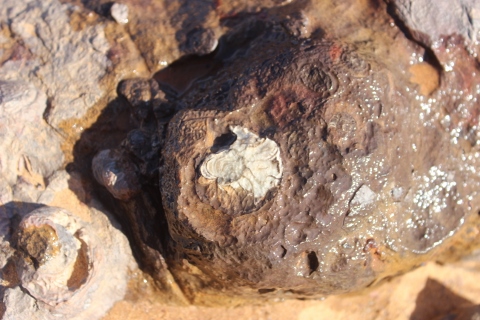
They were everywhere. See the rocks in this picture? Nearly every one you looked at had a fossil on it.

Melissa found a big 10 lb. rock covered on both sides with fossils. It probably has fossils all the way through it. She asked Barak if it was ok to take fossils home, and he said it was fine. Dave looked at Melissa dubiously. “You plan to put that in our luggage?” Big grin from Melissa, “you bet!”. Dave sighs. He knows there is no point in arguing. Later internet research shows that sure enough, the US doesn’t care if you bring home fossils and Morocco is fine with you taking them out. And TSA doesn’t even care if you put them in your carry-on luggage.
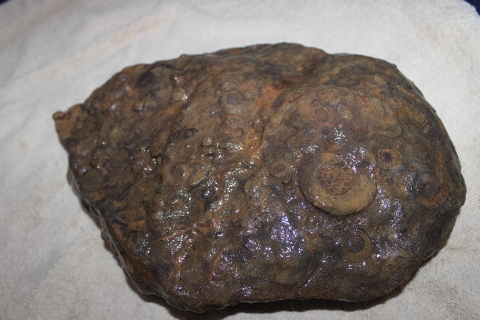
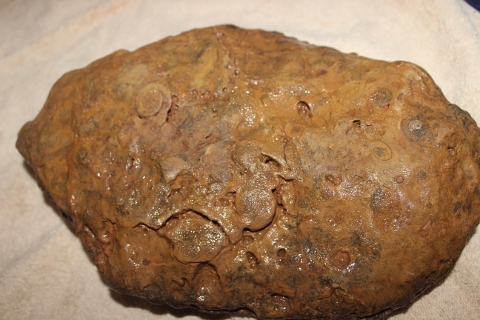
Then we drove to the other side of the field, and Barak showed us a fossilized tortoise.
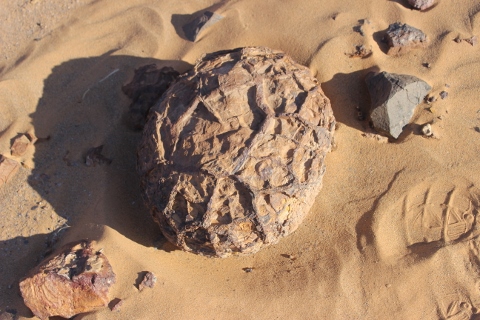
There were tons of them just lying on the sand. The red circle is the one in the photo above. The green circles are other turtles. Melissa asked if they could be polished up like so many other fossils to look cool. He said that no – the reason they were laying on the sand like that was that they don’t polish up to anything interesting.

A vendor at our next stop offered us this turtle fossil – about the size of your fist. Given that Barak had just told us they don’t polish she asked him if it was really a turtle. He said, “yes, only the little ones can be polished”. Hmmm. Dunno if I believe that. Sounds suspicious. The vendor offered it up at $15 US dollars. I was enamored of it so Dave offered $10. After a bit of negotiation, the guy caved and gave it to us for $10. Later internet research revealed it was not a turtle but fossilized coral. Genuine, and worth about $20 back in the US.
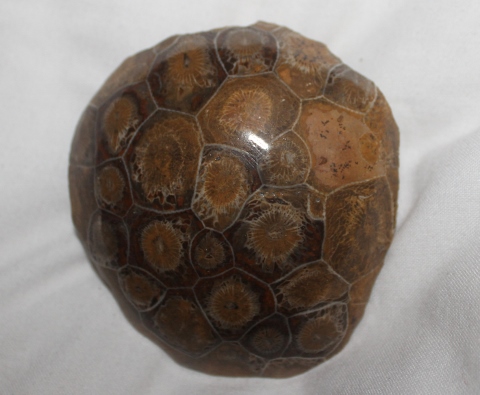
After the fossils, we headed off across the desert again to an ancient village. No one lives there anymore – there are just structures remaining.
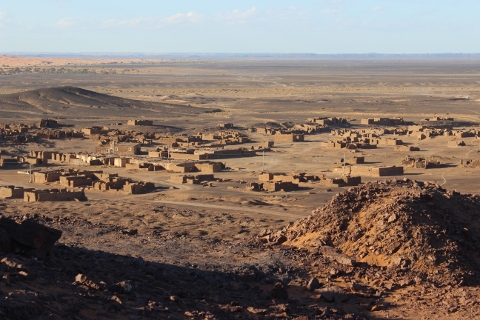
We climbed the hill above the village and the view was fabulous.

This is an area where they mine for minerals. Quartz (as in the picture below) along with hematite.
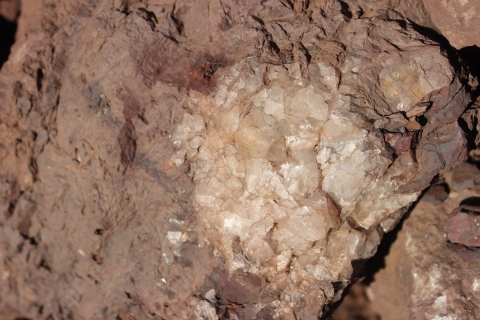
The remains of an old mechanism was here that was used to grind up the minerals.

Barak showed us a well used by the nomads for water. We stopped and he pulled up a bucket for us to see. Dave thinks the water temperature was around 55 degrees Fahrenheit – which should in theory be the average temperature of the desert. The water was totally clear, and the nomads drink it without further treatment. Though Barak suggested we not try it!
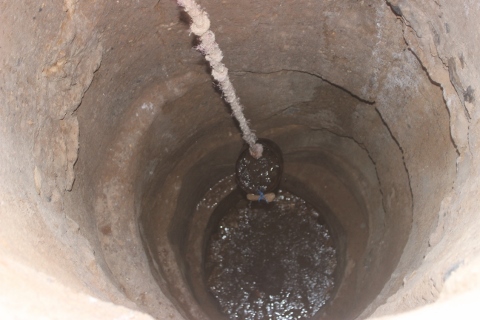
Then it was back out to the sand dunes. In this picture, the land you see at the furthest point away is Algeria. Weird to think we were only about 20 miles from the boarder. The boarder is closed, though Barak told us that the nomads move back and forth across the border regularly without restriction.

Then we got stuck. Barak would often stop at the top of a dune and get out to look around, sometimes backing down the dune because it was “no good”. Problem is that if the peak of the dune is sharp, as opposed to softly rounded, the truck won’t always make it over the dune. Barak dug us out easily and in another 5 minutes we were going again. We sort of suspect maybe this was a bit of show for the tourists, but who knows.
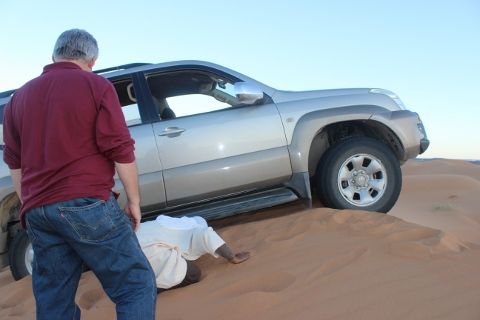
Next it was time to visit a Berber nomad. Her name was June. She lives in this tent:

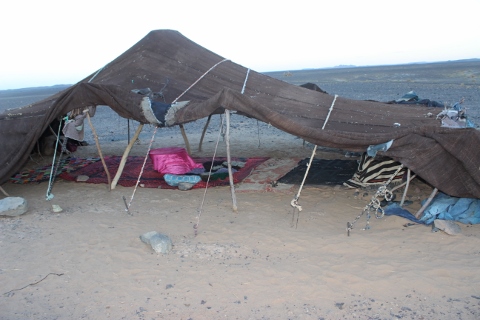
And cooks in this one with sticks and plastic bottles scavenged from the desert:
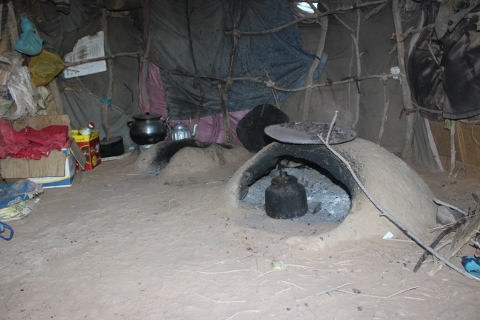
We sat inside the larger tent, and Barak told us that they weave the wool for the tent fabric themselves. In the lower right corner of this picture you can see the bag of wool she uses to weave. You can also see that the tent was patched with a denim shirt from who knows where.
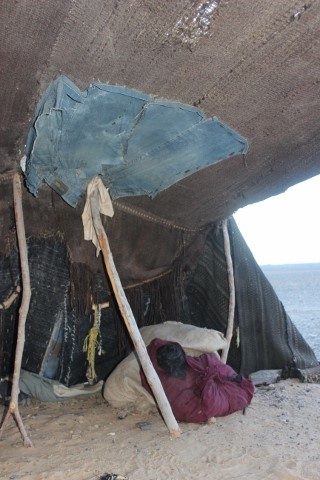
June prepared Moroccan mint tea for us with a plate of peanuts and bread with olive oil to dip it in. Barak poured it in the traditional way – holding the pot high in the air. We are told that this is to form bubbles on the surface of the tea which keep sand from getting in it. Suspicious of this explanation (which was given more than once) Melissa did some research. The truth is that if there is no foam, the tea is not ready to be served and needs to steep a bit longer, so the tea in the glass is poured back into the pot. In some areas, the method of pouring and returning the tea to the pot is used to mix the ingredients and is part of the ritual.
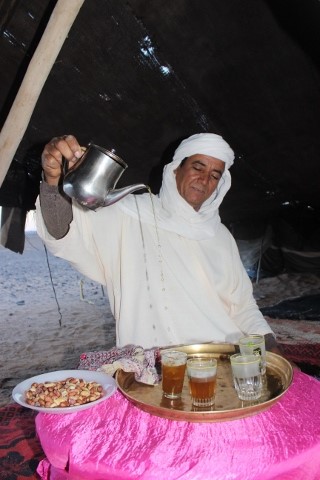
Melissa couldn’t eat the bread, but Dave gave it a try and said it was good but a bit bland (likely lack of salt). Amazing to think that June baked it herself in that kitchen tent.
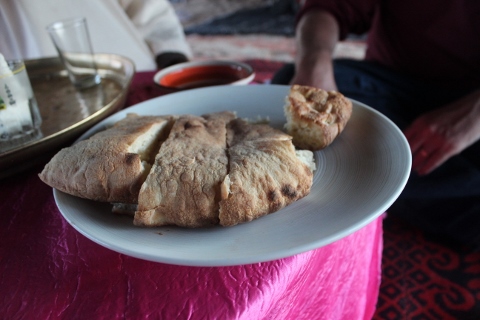
We asked where the nomads get their money and Barak explained that they sometimes raise a few goats and chickens to sell at the market. We asked how much they get for a goat and he said about $50 US dollars. So from there we decided the tip for the tea and bread should be about $2. Seems like a very little amount to us – but to them its totally appropriate and appreciated as the other way the nomads make money is off the tourists visiting. Another good data point - a full three course lunch is about $14.
Then it was back across the dunes, this time in the dark. Barak had to back out of the dunes twice before finding the right route to take us home. All in all, we are quite happy not to have spent today and tomorrow on the camels. We would have missed the fossils, and all the other fun we had today! At the end of the day, we realized that the dunes didn't actually reach across Africa the way we imagined when we first saw them because Barak took us all the way around them. They are really about 5 miles x 5 miles here in Morocco. Granted they probably go further in places like Egypt. But here you can't possibly get lost in the dessert - because you can climb to the nearest high dune and see your way out.
Back at the restaurant, we had a great dinner – lemon chicken tagine again.
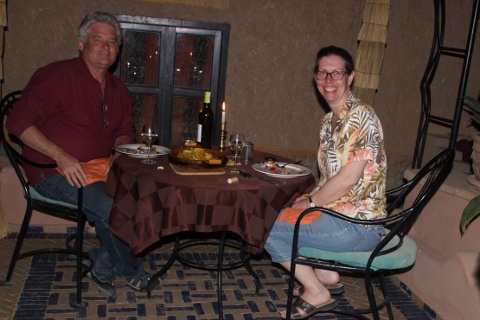
We ordered a white wine with dinner and were very amused with the handwritten note on the bottle – Blanc. Quite clearly to indicate to the hotel staff which this was – white, rose, or red. And then the next day a rose. Kudos to management for figuring out a system!
